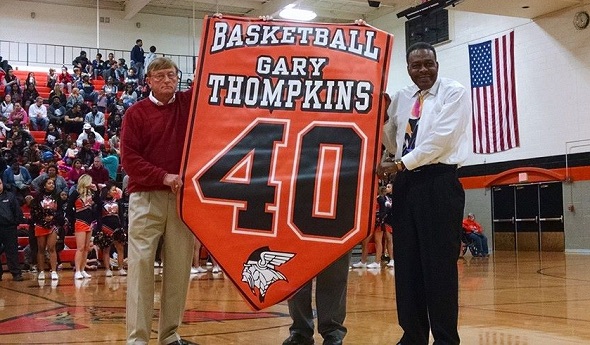
Jackson Remembers, Honors Hoops Hero
By
Chip Mundy
Special for Second Half
December 8, 2016
By Chip Mundy
Special for Second Half
JACKSON – More than 30 years ago, Gary Thompkins moved away from Jackson after his high school days. But he never really left home.
 He thought about leaving the sun and warmth of his Arizona home and coming back to Jackson, hopefully to coach the basketball team at his alma mater, Jackson High School. His son Zeke wanted to play at the same school as his father, and Gary's dream job was to coach the Vikings.
He thought about leaving the sun and warmth of his Arizona home and coming back to Jackson, hopefully to coach the basketball team at his alma mater, Jackson High School. His son Zeke wanted to play at the same school as his father, and Gary's dream job was to coach the Vikings.
While the coaching move wasn't in the cards at that time, Thompkins did return this summer to host a youth basketball camp at the old gym at his high school. He hoped it would become an annual event, and he planned to return again this month when his number would be retired.
On Sept. 3, less than a month after the camp and just 12 days shy of his 51st birthday, Thompkins died of a massive heart attack in Phoenix.
“It's just how life works,” said Jack Fairly, athletic director at Jackson. “He came home and ran that camp and a few weeks later he has a heart attack. Immediately you wish you would have retired his number sooner, but how do you know?
“It's a learning thing, too. Don't wait sometimes to tell people what you want them to know.”
The shocking news traveled through Jackson and his Thompkins’ friends like a lightning bolt. At his service in Jackson, one speaker said, “Growing up, we knew about Tony Dungy. We knew who the best football player was to come out of Jackson, but he was older than us and we didn't know him that well. When it came to basketball, we had Gary. Gary was our Tony Dungy.”
It seemed most everyone agreed, and in 2002, the Jackson Citizen Patriot named Thompkins the best high school basketball player in Jackson County history.
“He's the best player I ever coached, and it's not even close,” said Andy Sheridan, who coached Thompkins in high school.
Tuesday night, Jackson High School fulfilled its plan to retire Gary's No. 40 in a heartwarming, emotional ceremony. Gary's father, Bobby Thompkins, and Sheridan were on the court to reveal the banner as Gary joined his father and Regina Pierce as the only Jackson High School basketball players to have their numbers retired.
Following in Dad's basketball shoes
In the 1960s, Bobby Thompkins was the top basketball player in Jackson, and up until Tuesday night, he was the only male basketball player to have his number retired at Jackson High – a school that won Class A titles in 1948 and 1955.
“Bobby really pushed Gary and worked with him,” Sheridan said. “Bobby really wanted him to play, and that was a good thing.
“The thing is, though, if a kid doesn't want to play, he isn't going to play. I've had kids who had talent but didn't have the desire. Gary wanted to play all the time. If I could have opened that gym up 24 hours a day, he would have been in there 24 hours a day.”
 Bobby Thompkins was an inside player, and Gary was a point guard who could do it all. There were not many similarities.
Bobby Thompkins was an inside player, and Gary was a point guard who could do it all. There were not many similarities.
“Gary could go out and shoot it from 15, 20, 25 feet, and I was anywhere from 14 to 15 feet in, so I always played inside while Gary was outside,” Bobby Thompkins said. “But that was one of the things that Andy and I talked about as he grew up.
“It was to his advantage and his future for him to be able to handle the ball and play outside, and that is the way Andy coached him.”
It could not have been easy playing basketball in Jackson with the last name of Thompkins. But Gary embraced it. He was proud of his father but wanted to be better. He played with a swagger and had a flair for the dramatic. He was good, and he knew it. But off the court, he came off as just another guy.
“In 1984, his senior year, I was just back out of college, and I was substitute teaching,” Fairly said. “He gave me the time of day, and I was like some guy he didn't need to know. He was everything to us. He was our Mr. Basketball.
“The impressive thing is that he took the time to talk to me and get to know me. He shook my hand and introduced himself to me and made me part of what was going on with him just by being polite. Not every great star does that, and I think that spoke volumes about his character. So you root for a guy like that.”
Having Sheridan as his coach was a perfect match, too. Sheridan and Bobby Thompkins had been teammates on some fine basketball teams at Spring Arbor College and maintained their friendship throughout the years. Gary attended Jackson Catholic Middle School, but when it came time to choose a high school, he went to a public school for one important reason.
“Bobby called me and said, 'If you're going to be the coach, Gary is going to be at Jackson High,'” Sheridan said.
In Gary's senior season, Jackson won a Class A District title and won a game in the Regional tournament for the first time since 1969 before losing in the Regional Final. Thompkins left Jackson High with several impressive accomplishments: He finished second in the voting for Mr. Basketball – the highest finish ever for a Jackson County player – and was a two-time Class A all-state first-team selection and a four-year varsity player.
In the annual state high school all-star game that year, Gary was voted the Most Valuable Player. On Father's Day.
Thompkins established school records for career points (1,543), rebounds (801), assists (582) and steals (218). Those records still stand. He could do it all on both ends of the court.
He was heavily recruited by former University of Michigan coach Johnny Orr and played for Orr at Iowa State, where he teamed with another Michigan high school star – Flint Northwestern’s Jeff Grayer – and helped the Cyclones return to the NCAA Tournament for just the second time since 1944.
Perhaps the highlight was Iowa State's 72-69 second-round victory over Michigan in 1986 – a game that Orr called “my biggest victory.”
In four seasons at Iowa State, Thompkins had 900 points and 600 assists. He lived up to the hype.
Always living the game
After giving pro basketball a shot, Thompkins settled into a coaching and teaching role. He was a special-needs instructor and basketball coach at Greenway High School in Phoenix, and he was fondly known as “Coach G.”
Basketball wasn't his only focus, but it always was a passion.
“Gary was a great player, and he actually lived the game,” Sheridan said. “All the way through his coaching, he would call me so many times and tell me how his teams were doing and how his kids were doing. He really lived the game. He really did. Basketball was his thing.”
Not surprisingly, Thompkins' two step-sons are gifted in basketball. His oldest step-son, Sammy Barnes-Thompkins, played as a freshman last season at Boston College before transferring to Odessa College in Texas this winter to get more playing time.
 The younger step-son is Zeke Thompkins, a freshman at Greenway High School in Phoenix who already is catching the eye of college coaches. And it is Zeke who had a dream to one day play basketball at Jackson High – his father's school.
The younger step-son is Zeke Thompkins, a freshman at Greenway High School in Phoenix who already is catching the eye of college coaches. And it is Zeke who had a dream to one day play basketball at Jackson High – his father's school.
A few years ago, Thompkins considered moving back to Jackson to coach the Vikings and give Zeke the chance to play there. Although the job likely would have been his had he wanted, things didn't match up. But it remained a dream.
“What they did in Arizona was make him a permanent sub, and being that he was a permanent sub, he automatically could coach and support his family,” Bobby Thompkins said. “That was one of the pieces that I think was missing in regards to coming home, but he wanted his kids to play here and wanted to coach here.”
It was with a ton of pride that Gary returned to Jackson on Aug. 13 to hold a shooting camp at Jackson High School. It was interesting that instead of holding the camp in the current gym – the one in which he played – he wanted the camp to be held at the cozy old gym that housed the two MHSAA championship teams and is filled with character.
It was his way of giving back and staying in touch with his old school. He had hoped to make it an annual event that would grow in size each year.
“It was a hot day, and Gary did a great job with the kids for us,” said Dan Crowley, Jackson High boys basketball coach. “He was very gracious to everybody.
“He was looking forward to coming back for the first game when his number was retired.”
Instead, the ceremony went on without Gary. It was heartbreaking and uplifting at the same time, especially for his family.
“The way in which I’m dealing with it is that it's an opportunity to do something for a young man who was successful,” Bobby Thompkins said. “I have to thank the school district and also thank Andy and Jack, who also have promoted this, and at the same time, this might give an opportunity for others to have the opportunity to have their numbers retired. It would be great for their families.
“Also, it's a positive reinforcement for our community, giving honor and respect that is needed for those who were successful.”
Gary Thompkins left a legacy in Jackson as versatile as his playing skills. He was fierce and confident on the court. He was nice and gracious off it. And he possessed a tremendous love for his family, his sport and his high school that stayed with him until his final days.
He packed a ton of living into his nearly 51 years. It would have been a surprise if he hadn't.
 Chip Mundy served as sports editor at the Brooklyn Exponent and Albion Recorder from 1980-86, and then as a reporter and later copy editor at the Jackson Citizen-Patriot from 1986-2011. He also co-authored Michigan Sports Trivia. E-mail him at [email protected] with story ideas for Jackson, Washtenaw, Hillsdale, Lenawee and Monroe counties.
Chip Mundy served as sports editor at the Brooklyn Exponent and Albion Recorder from 1980-86, and then as a reporter and later copy editor at the Jackson Citizen-Patriot from 1986-2011. He also co-authored Michigan Sports Trivia. E-mail him at [email protected] with story ideas for Jackson, Washtenaw, Hillsdale, Lenawee and Monroe counties.
PHOTOS: (Top) Former Jackson coach Andy Sheridan (left) and Bobby Thompkins hold up the banner signifying the retirement of Gary Thompkins’ number during Tuesday’s ceremony. (Middle) Gary Thompkins, during his high school career with the Vikings. (Below) Gary Thompkins, left, with former high school teammate and current NCAA Division I college official Earl Walton during Thompkins’ camp at Jackson High in September. (Top photo by Laura Quinn; middle photo courtesy of the Jackson Citizen Patriot.)
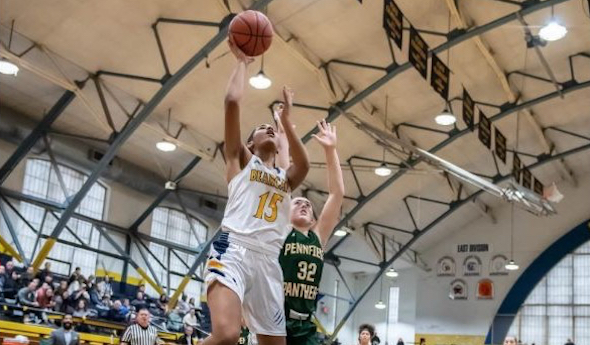
Hoops Finds Annual Home During Holidays
December 27, 2019
By Ron Pesch
Special for Second Half
Nothing says the Holidays like a high school basketball tournament.
It started, like many things do, with a drip. Well, make that a dribble.
The Michigan High School Athletic Association has allowed Holiday basketball tournaments for years. When was the first? That’s hard to establish. No one really kept track of such. A 1934 Wakefield News article indicates that a “Christmas Tournament will be held for the (Gogebic) Range teams at Wakefield December 27 and at Ironwood December 28.” Hurley, Bessemer, Ironwood and Wakefield were entered in the “blind” tournament, with opponents drawn just before game time. It was a new idea, at least in the Upper Peninsula.
“Nothing of its kind has ever been attempted in the Peninsula before,” stated the Ironwood Daily Globe. The tournament, won by Hurley, was a financial success. After expenditures, including the purchase of trophies, profit equaled enough that $22.42 was distributed to each school competing in the tournament. Plans were announced to bring back the tournament in a larger format the following year. It did return the following December, with the same teams in the same format but with all games played in Wakefield. This time out, Ironwood topped Hurley 22-21 for the tournament title.
In the Lower Peninsula in 1935, an All-Berrien County Holiday tournament was held Dec. 26, 27 and 28, with Three Oaks winning the Class B-C division title, 15-13 in the final over Berrien Springs. St. Joseph Catholic emerged as the Class D victor with a surprising 27-26 win over the reigning MHSAA state champ from Stevensville. The 14-team competition was played at Niles High School. Attendance was “slim, very slim” for the opening day of the tourney. The event did not return in 1936.
A similar, but much smaller, event was staged in Berrien County in 1941 with the Bridgman Class C Invitational. The tournament featured seven teams with contests spread over three nights. It was a success.
“Some 450 paid admissions were checked in Wednesday night for the championship finals, which Bridgman won from Berrien Springs. … The total paid admission for the three night event was 1,420 fans with a gross gate of approximately $400.”
By the mid-1940s, the idea of playing prep basketball during the Christmas lull had begun to take off across the state.
In December 1946, before a crowd of 1,500 at the Flint IMA Auditorium, Holland, the reigning Class A champion, downed Flint Northern 51-48 behind a pair of late field goals by Ken ‘Fuzz’ Bauman in the first annual Motor City Invitational. In Jackson, Detroit Catholic Central won the Michigan Catholic Invitational, beating Kalamazoo St. Augustine, 42-40. Bridgman again snagged the title at the Sixth Annual Berrien Class C Christmas Holiday Tournament. It was the Bees’ third Christmas championship in four years. The Little Eight Conference Holiday Tournament was played across four school gymnasiums as the calendar transitioned from 1946 to 1947. Bangor downed Covert, 34-29, in the championship contest hosted at Watervliet High School on Saturday, Jan. 4.
“Holiday tournament basketball has really caught on in Michigan,” said Hal Schram in the Detroit Free Press in 1947. “There will be no Christmas-New Year’s rest for at least 60 Michigan high school squads which have jumped at the chance to sharpen their collective shooting eyes for the long season ahead. … At last count, tournaments will be played between Dec 17 and Jan 3 at Flint, Saginaw, Grand Rapids, Jackson, Lincoln Park, Fremont, Negaunee, Marquette, Benton Harbor and Detroit.”
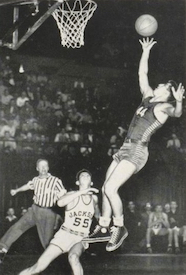 The same eight schools that played at the first Motor City tournament – Jackson, Grand Rapids Central, Holland, Muskegon Heights, Monroe, Midland, Flint Central and Flint Northern – were invited back for the second year. According to Schram, “Not a single participating school of a year ago wanted to be left out.”
The same eight schools that played at the first Motor City tournament – Jackson, Grand Rapids Central, Holland, Muskegon Heights, Monroe, Midland, Flint Central and Flint Northern – were invited back for the second year. According to Schram, “Not a single participating school of a year ago wanted to be left out.”
Jackson downed Flint Northern in the title game, 39-34.
The Saginaw Invitational, hosted at Arthur Hill High School, boasted six Class A schools as well as Alma and Mount Pleasant, both Class B schools. Mount Pleasant surprised the field, winning the tournament with a 40-25 triumph over Dearborn Fordson in the championship game.
A year later in December, Schram wrote, “The Michigan High School Athletic Association wasn’t caught unaware when the tournament bug started to bite every sector of the state.”
“Never did we expect such a wave of tournament play as we will see during the next three weeks,” said Charles Forsythe, state director for the MHSAA, noting 34 Christmas vacation tournaments were scheduled between December 15 and January 8 during the 1948-49 basketball season. “Perhaps we’re lucky at that. The Oklahoma association has had to sanction 123 tournaments.”
Forsythe and Schram explained the reasons for the wave of popularity. Of particular interest was the fact that, at the time, a school sponsoring both football and basketball could play a total of no more than 24 games, combined, in the two sports. However, MHSAA rules allowed a basketball team the chance to play as many as three games during a Holiday tournament and be charged with only one of its allotted combination of 24 contests. (The MHSAA rules changed prior to 1972-73 to allow basketball teams a maximum of 20 games.)
Coaches could keep their squads sharp during the two-week layoff with games rather than just mandatory practices. And, as a bonus to all because tournaments were financed through gate admissions, invitations to larger tournaments meant teams got to “stay and eat at the best hostelries, go on sightseeing tours when not playing and play non-conference opponents from other sections of the state.“
Add in the chance to play before larger-than-normal crowds, and the formula for a successful tournament was cast.
Beginning with the 1950-51 season, the football-basketball rule was altered to count play in mid-season invitational tournaments as two contests. With the change, according to the Detroit Times, “the number of such meets dropped sharply.”
Only nine Holiday tournaments, involving 50-plus teams, were recorded by the MHSAA during the 1951-52 season: the 5th annual Flint Parochial Invitational, the Alpena Catholic Invitational (involving 16 teams), the 5th Annual Greater Lansing Invitational, the Albion College Invitational, the Twin-Five Conference Christmas Tournament (a 10-team replacement for the disbanded Little Eight Conference’s tournament), the Otisville Invitational, the Columbiaville Invitational and the 1st Annual Portland St. Patrick Christmas Invitational.
But by the 1960s, Holiday Tournaments were again regaining popularity, with more now focused on teams from a specific community or section of the state, especially among smaller schools.
The St. Patrick tournament was still going strong in 1966 – its 15th year – with an eight-team, four-day design. Williamston downed a Cinderella squad from Carson City, 64-44, before 1,100 fans at Portland to earn the championship. Other Mid-Michigan holiday tournaments played out in Chelsea and Swartz Creek at the same time.
The Flint Parochial League Tournament was a mainstay of the Holiday season until the breakup of the league in the early 1970s.
“Basketball tournaments have become popular around the state and nation in recent years,” wrote Wendy Foltz, longtime Battle Creek Enquirer sports editor, before the kickoff of the inaugural Battle Creek Central Holiday Cage Tournament in 1968. In a twist that harkened back to earlier days, the eight-team event represented nearly every section of lower Michigan. “Battle Creek never has been a rabid basketball town like some around the state,” added a hesitant Foltz, noting a hope that the event could at least break even.
Hosted at the Cereal City’s historic Fieldhouse, built in 1928, that first tournament was won by host Battle Creek Central, which downed Traverse City 71-53 before a crowd of 2,000. Phil Todd led the Bearcats with 29 points, including 21 in the first half, while 6-foot-8 Tom Kozelko paced TC with 24. Muskegon Heights won the consolation game, holding off a late Ypsilanti Willow Run rally, 78-77. Other schools competing were Battle Creek Lakeview, Grand Blanc, Romulus and recently-opened Jackson Lumen Christi.
Chuck Turner, Central’s head coach, and junior varsity coach Jack Schils had contacted 60 schools during the summer of 1967 to organize the 12-game schedule.
“The response was terrific,” said Schils, who added, “Many schools could not accept because of schedule commitments but want to enter a year hence.”
The Battle Creek tournament was back in 1969, again hosting teams from near and far. Schils noted that cost ran high when teams were brought in from long distances: “However, this type of tournament is highly desirable so we hope fans will support it.”
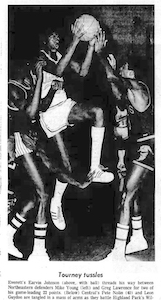
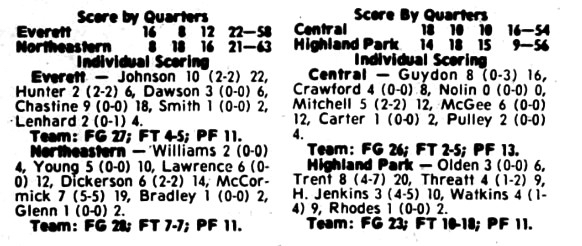 But the event was discontinued following the 1970-71 season when the “eight team format became too unwieldy,” according to the Enquirer “… and both crowd and the quality of play declined.”
But the event was discontinued following the 1970-71 season when the “eight team format became too unwieldy,” according to the Enquirer “… and both crowd and the quality of play declined.”
Pared down to a four-team format, it returned in a big way in December 1975. The tournament saw standing-room-only crowds of more than 3,000 for games between Battle Creek Central, Detroit Northeastern, Class A quarterfinalist Lansing Everett and reigning Class A champion Highland Park.
Detroit Northeastern downed Lansing Everett, 63-58 for the Cereal City championship trophy. Everett junior Earvin Johnson scored 22 points and, with teammate Reggie Chastine, was named to the all-tournament team along with Northwestern’s Wilbert McCormick, the tourney MVP, and his teammate Greg Lawrence. Highland Park’s William Trent and Battle Creek Central’s Leon Guydon also were named to the team.
By the 1980s, it seemed that the Christmas break nearly mimicked March in Michigan.
“I think a Christmas tournament really helps your program,” said Turner in 1980 to the Enquirer. He had taken over the head coaching position at Battle Creek in the fall of 1967 after a successful stint at Willow Run. “I don’t understand basketball teams having a preseason, playing three or four games, then taking two weeks off. When you get back, it’s like starting over.”
Besides Turner’s squad, the 1980 field included Detroit Western, Detroit Murray Wright and eventual winner Kalamazoo Central. The event would ultimately be re-christened the Battle Creek Central Chuck Turner Holiday Classic.
“The late Chuck Turner started bringing big games to the city over the holidays when he first started at the school in the 1960s,” wrote Bill Broderick in the Enquirer in 2018.
“Chuck started this because he wanted to give people the chance to come back home for the holidays and see everyone play. It’s been like a family reunion over the years,” Fred Jones told Broderick. Jones was a longtime assistant to Turner. “That we can keep it going in his name is great and hopefully we can keep if going for another 50 years.”
The girls are now part of the action. All five Battle Creek city schools – Central, Pennfield, Harper Creek, Lakeview, and St. Philip – were part of the event in 2018.
This year the Chuck Turner Central Field House Holiday Classic will again span two days – December 27 and 28 – and will again see all five city schools play on the historic floor.
Other Holiday tournaments scheduled this year include:
Petoskey Invitational – December 13-14
Raider Shootout – December 21
18th Annual Muskegon Area Sports Hall of Fame Classic – December 27
Earl McKee Classic – December 27-28
North Farmington Holiday Extravaganza – December 27
Motor City Roundball Classic – December 27
Cornerstone Invitational – December 27
Washtenaw Hoops Showcase – December 28
 Ron Pesch has taken an active role in researching the history of MHSAA events since 1985 and began writing for MHSAA Finals programs in 1986, adding additional features and "flashbacks" in 1992. He inherited the title of MHSAA historian from the late Dick Kishpaugh following the 1993-94 school year, and resides in Muskegon. Contact him at [email protected] with ideas for historical articles.
Ron Pesch has taken an active role in researching the history of MHSAA events since 1985 and began writing for MHSAA Finals programs in 1986, adding additional features and "flashbacks" in 1992. He inherited the title of MHSAA historian from the late Dick Kishpaugh following the 1993-94 school year, and resides in Muskegon. Contact him at [email protected] with ideas for historical articles.
PHOTOS: (Top) The Battle Creek Central and Pennfield girls face off during the 50th Chuck Turner Classic. (Middle) Shaheen Shaheen scores two points for Flint Northern, which fell to Jackson 39-34 during the 1947 Motor City championship game. (Below left) Lansing Everett’s Earvin Johnson makes a move toward the basket against Detroit Northeastern during the 1975 Battle Creek event. (Below right) Box scores from the 1975 tournament include Johnson’s 22 points in the 63-58 loss. Photos courtesy of the Battle Creek Enquirer, Lansing State Journal and Ron Pesch archives.)

